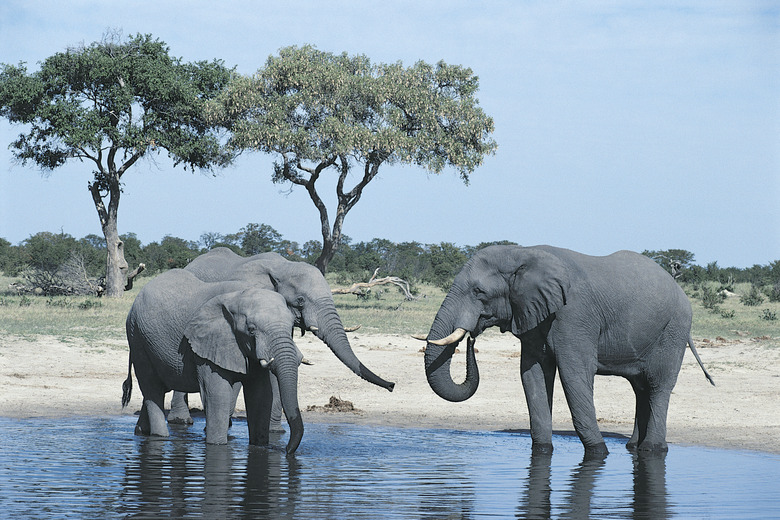Can An Elephant's Tusks Be Pulled Out Without Killing The Animal?
Elephant tusks aid them in carrying out tasks. However, humans highly prize tusks for their ivory. The U.S. Fish & Wildlife Service Forensics Lab defines ivory as "any mammalian tooth or tusk of commercial interest which is large enough to be carved or scrimshawed."
The elephant's tusks are a clear example of this, and poachers go to great lengths to collect them. Unfortunately, their methods almost always end in the elephant's demise.
Tusks Defined
Tusks Defined
Tusks are elongated incisor teeth. Most male Asian and male and female African elephants have two tusks, which grow continuously throughout their lives. Each tusk can grow to weigh more than 100 lb. and at one point in the not-so-distant past, elephant tusks regularly weighed in at more than 200 lb.
However, due to the extent of poaching in Asia and Africa, the "big tusk" gene for these animals has all but vanished from the population. As much as 50 percent of male elephants in the Asian population don't grow tusks at all. Scientists believe this may be an evolutionary response to poaching.
Other Animals with Tusks
Other Animals with Tusks
Elephant tusks are the most famous, but there are many other animals with tusks around the world.
Walrus tusks look very similar to elephant tusks. Walruses are aquatic creatures found in the cold waters of the Arctic ocean. Like elephants, walrus tusks grow throughout their lives and in pairs on either side of the mouth.
However, walrus tusks grow straight down instead of curled up. Walruses use them for lifting themselves out of the water, for dominance battles and for reproductive displays.
Another famous example is the narwhal. Narwhals are whales also found in Arctic waters. Their tusk grows to ~8 feet in length and protrudes from their upper jaw. It resembles a unicorn horn. Only male narwhals have tusks.
Wild pigs and hippos are two more examples of animals with tusks.
Purpose of Tusks
Purpose of Tusks
Most of the time, elephants use their tusks as weapons against other elephants and predators such as lions and hyenas. Elephants also use tusks to forage, dig and carry things. This wear and tear can easily damage the incisors, but they can heal with time. If their tusks are injured in the root area, however, it can lead to intense pain for the animal.
Ivory Removal
Ivory Removal
The bottom third of each elephant tusk is embedded within the skull of the animal. This part is actually a pulpy cavity that contains nerves, tissue and blood vessels. However, it too is ivory. To remove that section, the tooth must be carved out of the skull.
This fact is one of the major reasons why poachers kill the elephants. The other reason is that full-grown elephants are extremely large and dangerous, especially when they feel threatened. The only way a tusk can be removed without killing the animal is if the animal sheds the tooth on its own.
Ivory, Revenge and Food
Ivory, Revenge and Food
The ivory trade is still thriving in Africa and Asia despite a ban on the trade of ivory by the Convention on International Trade in Endangered Species (CITES) in 1989. CITES backed off its ban slightly in 1997 when it allowed Japan to buy the stockpile of ivory from three African nations.
Poaching also takes place within the confines of refuge areas. In 1993, for example, 1,300 African elephants were found slaughtered with their tusks taken in the Congo's Nouabale-Ndoki National Park. Farmers in Africa and Asia also kill elephants out of spite because the animals can sometimes damage or eat crops, destroy fences and trample the land.
Cite This Article
MLA
Trippeer, Jordan. "Can An Elephant's Tusks Be Pulled Out Without Killing The Animal?" sciencing.com, https://www.sciencing.com/can-elephants-tusks-pulled-out-killing-animal-10058725/. 12 June 2019.
APA
Trippeer, Jordan. (2019, June 12). Can An Elephant's Tusks Be Pulled Out Without Killing The Animal?. sciencing.com. Retrieved from https://www.sciencing.com/can-elephants-tusks-pulled-out-killing-animal-10058725/
Chicago
Trippeer, Jordan. Can An Elephant's Tusks Be Pulled Out Without Killing The Animal? last modified March 24, 2022. https://www.sciencing.com/can-elephants-tusks-pulled-out-killing-animal-10058725/
